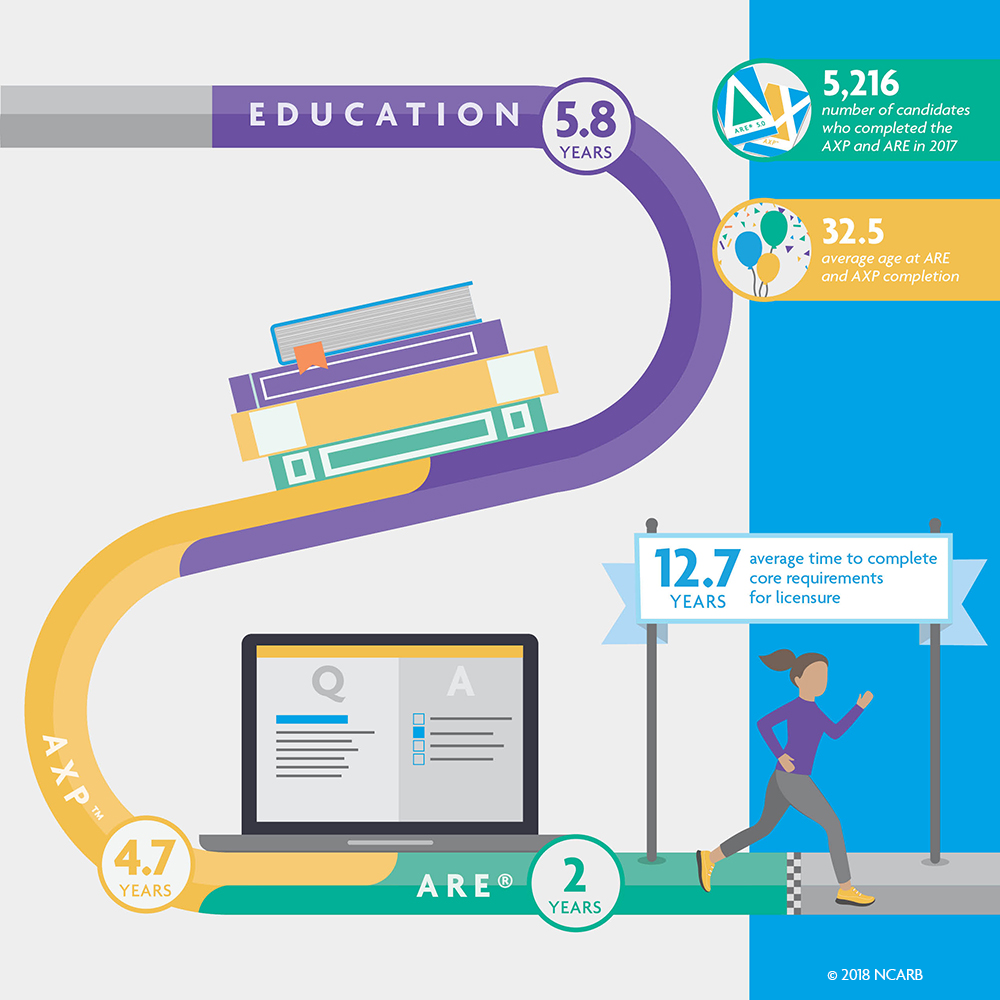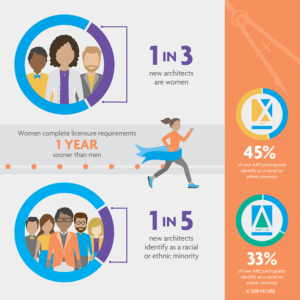It’s Official: Tracy A. Stone Architect has a newly-licensed architect in our office!
As of February 1, MacKenzie Leifeste is a licensed architect. Many friends and colleagues weren’t familiar with the process, so we thought we’d share MacKenzie’s take on the architectural licensing process and tips for any future architects-in-the-making.
What It Takes
We’ll let MacKenzie take it from here to describe her backstory: the required education, work experience, licensing process and overall sleep deprivation required to become a licensed architect.
My journey…
Think you know what it takes to become an architect? Take this 10-second quiz:
How many years of school/work experience is required to become a licensed architect in California?
-
- None
- 4 years
- 8 years
How many exams does architecture licensure require in California?
-
- One 8-hour exam
- Three 5-hour exams
- Seven 3- to 4-hour exams
What percentage of test takers pass the exams nationwide?
-
- 76%
- 63%
- 56%
If you answered 1 or 2 to any of these questions, guess again! The process of becoming a licensed architect is long and pretty darn difficult!
Becoming licensed is as easy as 1, 2, 3…or so they say.
To be an architect, you’ve got to get your 3 E’s covered: Education, Experience, and Examination. Get yourself a degree in architecture (or don’t — more about that later), snag a position at the coolest local architecture firm for some real-life experience, and then show off your skills via some really, really hard tests. Piece of cake, right?! Don’t worry — it will only take you 12+ years!

Where it all started for me:
Everyone always wants to know what led you to your career, but can anyone actually remember that? I can only guess the turning point was when I found out that a grocery store bagger wasn’t a lucrative career. Next thing you know, a high school career assessment suggested Architecture and Event Planning may be up my alley.
As part of the career education class, we were required to do a job shadow. Being the over-achiever that I am, I did three. My first job shadow was for an event planner out of Lincoln, Nebraska. What that really translated to was shadowing a crazy old cat lady who happened to do wedding flower arrangements out of her sketchy mini-van. Pass! Next, I shadowed two architects. The first drove a Mini Cooper (I’d never seen one of those before!) and took me around to job sites showing off his work. A friend, Ryan, also wanted to shadow an architect so we scheduled the second architect shadow jointly. First thing in the morning, this architect sat down in the conference room with Ryan and me to explain a “day in the life” and next thing you know, we hear snoring. Unfortunately, by we I mean the architect and I. Ryan was clearly not intrigued and had dozed off during this intimate conversation. Needless to say, Ryan did not become an architect.
My interest in architecture and drafting continued and I went on to take several drafting classes in high school. I even did an independent study to teach myself Autocad by translating all of my hand drawings to the computer. When looking for colleges, I sought out schools with an architecture program. This led me to Woodbury University in sunny Burbank, California.
Which leads me to the first “E”
1. Architecture Education
The easiest path:
If you want to become an architect, the most straightforward start is with an architecture degree. This could be either a Bachelor of Architecture (B.Arch) or a Masters of Architecture (M.Arch) from an accredited university. In a shameless plug to my alma-mater, Woodbury University is a great place to check out.
Contrary to popular belief, getting an architecture degree does NOT make you an architect. You’re only a third of the way there!
My convoluted path:
Technically, I was in the Interior Architecture department so my degree is a Bachelors of Fine Arts (BFA) in Interior Architecture. At the time, I was content with my degree choice had no intention of being licensed and quickly learned that in an office, only one person has to stamp the drawings (ahem, Tracy). At Tracy A. Stone Architect, all work is completed under Tracy’s supervision. It is 100% possible, if not most common, to work in an architecture office and not be licensed.
About two or three years after working at Tracy’s office and checking off all the other boxes on my to-do list (obtaining my LEED Green Associate and passing all the NCIDQ Interior Design Certification exams), I figured “Why not keep going?” In 2015, I realized California doesn’t require an architecture degree and I could do an “Education Alternative” route, which really is just a fancy way of saying you need more work experience to make up the difference. This started my next four-year “Becoming an Architect” journey gaining my next “E”…
2. Architecture Work Experience
In the State of California, the magic number of required experience is eight years, folks. Plus, one gets different amounts of credit for various degrees, or the lack thereof.
The easiest path:
Best-case scenario, as noted above, are the architecture degrees that credit you five to six years of experience depending on the type and only require an additional two to three years of work experience.
My convoluted path:
No degree? Then you’ll need a full eight years of experience. For my degree, I only received two years of credit, so I had to work for six years before I could be officially licensed.
In addition to California’s eight-year total, NCARB (the governing body that regulates the eligibility and exams) also requires at least 3,740 hours, referred to as AXP, of task-specific experience that runs parallel to California’s experience requirements. For example, NCARB want each candidate to have at least 1,520 hours of experience in project development and documentation. Luckily, as a junior person on the team, the construction document hours were pretty easy to obtain…is what I would have said if I did the most logical thing! Remember I decided to start this whole architectural license process several years into my experience. NCARB has a rule that you have to report all experience within eight months of receiving it. Yeah…so those first four years at Tracy’s as junior staff only got me half-credit and I lost the credit on over 1800 hours of super-valuable experience.
PRO TIP: Log your experience hours on NCARB even if you don’t think you’re going to become licensed. If you ever change your mind, you will thank me later!!
FUN FACT: NCARB recently published statistics indicating it actually takes architecture licensure candidates an average of 4.1 years to fulfill the required task-specific hours for NCARB. That’s more than twice the number of hours that are actually required! Pretty crazy, huh?
3. Architecture Examination
The Architect Registration Exam (ARE) 5.0 is the latest version of the licensing exam and includes six different tests covering topics from site constraints to contracts to design. The tests can be taken in any order at whatever times are available at the testing facility on a five-year rolling clock. If you remember the statistic from above, on average only 56% of people pass these things! It is not uncommon to hear about friends or colleagues failing the exams, sometimes more than once.
I will admit I failed my first exam in October 2015, and I’d like to think I’m one of the sharper tools in the shed. In ARE 4.0 (the previous version), there were three components: a question/multiple choice part, and then two drawing vignettes. I was so confident that I had performed well that when I saw the score report I was extremely deflated. I had passed the questions and one vignette. I had failed the second vignette, and thus, failed the entire exam. It sucked and I lost motivation.
Many people don’t realize the amount of content you need to be familiar with for the architecture exams. I studied for six to eight months and still there would be words I’ve never even heard before on the exam. Mind you, I’d been working in architecture for five years at this point. I left most exams feeling confident with 30% of my answers.
In 2017, I got my groove back and secretly scheduled a couple exams without telling anyone. I didn’t want to repeat my giant failure and have people asking about it, making it worse! I miraculously passed three exams in a row, and then officially transitioned to the latest ARE 5.0 testing system (which allowed me to take a total of five exams instead of six). Saving the two most difficult exams for last, I studied and studied and studied some more. My friend and studying partner took both of them and failed, twice, so I wasn’t feeling confident or prepared. I woke up one morning in early 2018 and thought “what the heck” and scheduled both with two weeks’ notice. Either I knew the content, or I didn’t. And I passed! I was officially done with the ARE.
Once you’ve met the challenge of the ARE exams, the State of California blesses us with one more test called the California Supplemental Exam (CSE). This last exam covers all the topics specific to the West Coast. For this last test, I decided to do it a day before my Christmas vacation but made a total rookie mistake on scheduling. Being my secretive self, I told no one and scheduled it for a Tuesday at 6 p.m. thinking it would be simple and only take a couple hours. Wrong. Two hours in and only half-done, I was starving and getting a headache. I ended up needing every last minute of the 3.5 hour exam to finish all the questions. It was painful, literally. By the end, I was just selecting an answer and hoping for the best. When I walked out of the testing room 100% certain I had failed, they handed me the letter to apply for my license because I’d passed. I almost fainted in surprise.
PRO TIP: Eat a freakin’ sandwich before going to the testing facility! The exams are long and require every last brain cell you have, and then some.
Phew, didn’t that sound fun? Ready to be an architect?
To get from education to licensure, it takes about 12.7 years with the average completion age being 32.5 years old. When I first read those statistics, I thought it was an exaggeration. But here I am, leading the masses at 11.5 years from start to finish and passing the last exam three weeks before my 30th birthday. It literally took six weeks for the State of California to process my license, but as of February 1, I was listed in the database and several weeks later I got the physical proof.
FUN FACT: I always thought the infamous license was a big certificate on the wall. In reality, it doesn’t look much different than a nail tech’s license taped on the wall of the salon.

FUN FACT: As of 2018, only 20% of licensed architects are female but this trend seems to be changing with one in three new architects being women. And, they are completing their experience and exams about one year faster than their male counterparts. Go Ladies!
In closing, if you or anyone you know is interested in architecture, I have a few tips to save you some struggles along the way. I’m happy to answer any questions, so shoot me an email or swing by our office if you want to chat.
- Many people believe to be licensed you either need a Bachelors in Architecture or have to go back to school for a M.Arch degree if you have a non-architecture Bachelor’s degree. This is not true, and I would personally suggest getting the hands-on experience instead of going back to school. My Interior Architecture degree (high five, Woodbury University!) was more than sufficient and the architecture experience after I graduated far outweighed what I think I could have learned in a master’s program (with far fewer late-nighters, too!).
- Start logging your architecture experience with NCARB as soon as possible! I made a rookie mistake and wasn’t sure if I wanted to be licensed when I started working, so I didn’t log any of my hours. Sadly, any experience older than eight months only gets half-credit. My first three years of work experience, when you are naturally the slowest at completing tasks, were only given half-credit. Don’t make that mistake!
For more information on getting licensed as an architect, a great place to start is by checking out NCARB and the California Architect’s Board.
**All graphics are borrowed from the latest 2018 “NCARB by the Numbers” report, graphically showing really interesting statistics for the architecture community.


